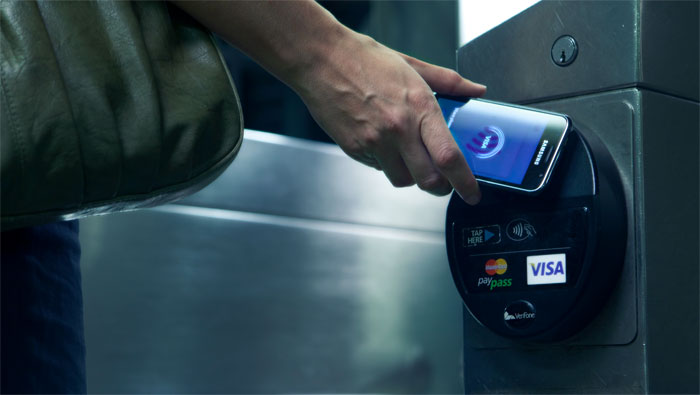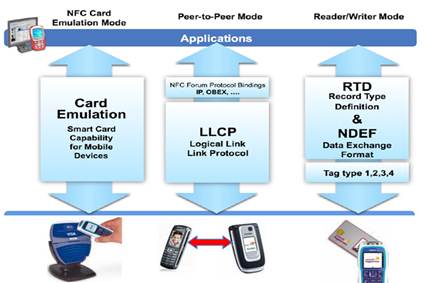Non-standard use of NFC in ACS
Because NFC technology is an extension of the ISO 14443 standard that integrates a smart card and reader interface into one device, a smartphone with an NFC chip can communicate with:
- cards that support this standard;
- ISO 14443 readers;
- other NFC devices.
The main application of NFC technology in modern access control systems is the use of a smartphone as an access identifier, i.e. one or more passes, for example, to an office, to an educational institution, to a car park or stadium, and to other places with limited access.
This approach eliminates the need for the user to carry multiple cards and passes, and reduces the risk of forgetting or losing the pass at home.
There are already several solutions from well-known world manufacturers with support for NFC technology on the ACS market.
Gartner estimates that by 2020, around 20% of organizations globally will be using mobile credentials for physical access instead of traditional IDs. However, this is not the only way to use this technology in ACS.
A smartphone as a multifunctional device with sufficient computing power, large memory capacity and the possibility of mobile data transmission, for example, via the Internet, makes it possible to implement several convenient and effective solutions for use in access control systems on its basis.
The presence of a built-in NFC module in a smartphone or tablet allows you to use them as mobile readers. In this case, both other smartphones with NFC and cards that comply with the ISO 14443A standard, for example, the Mifare family popular in ACS, bank cards with support for PayWave and PayPass technologies, can act as identifiers.
1. Patrol control.
2. Organization of a mobile hotspot.
3. Reconfiguring various devices.
Let’s take a closer look at each of these options.
Patrol control is reduced to a guard walking around the territory along a given route (a certain order of passing control points with a certain frequency). This task, as a rule, is solved by installing RFID tags at control points, the data from them is read by a special device made in the form of a baton worn by a security officer.
A smartphone with an NFC chip and specialized software can successfully replace such a wand, and checkpoints can be equipped with NFC tags. Such tags can be made not only in almost any form factor, but also be frost and moisture resistant, which allows them to be used in any climatic conditions.
Since a smartphone has a screen, a built-in camera, a microphone, a GPS module, it can be used to significantly expand the functionality of such a solution by adding additional features, such as:
- transmission of images, voice messages;
- use of other types of labels, such as a QR code;
- instant messaging (using a messenger);
- real-time device location;
- setting up various types of notifications to responsible persons about recorded incidents.
Only the capacity of the battery of the device and its case, as a rule, are not suitable for use in difficult conditions (harsh climate, the possibility of falling and other emergency situations) can cause a question. However, the answer to this can be smartphones with increased battery capacity, waterproof and shock-resistant housing.
Similar solutions already exist on the market, and some of them can be used to automate similar tasks from other areas, for example:
- industry: inspection of units by a technician before the start of the work shift;
- rail transport and subways: bypassing railroad tracks;
- retail chains: control of the time of delivery of goods by a forwarder to retail outlets;
- hotel sector: control of the work of service personnel, etc.
A standard ACS task – restricting physical access and registering employee passes – can be solved in a non-standard way using a smartphone with an NFC chip. With specialized software, such a smartphone can act as a reader and ACS controller at the same time, reading data from identifiers applied by passing people.
Solutions of this kind have been implemented by several ACS manufacturers and are in high demand on the market. There can be several tasks that can be solved with the help of such solutions:
- Corporate transport – comfortable registration of the passage of employees at the entrance to the territory of the enterprise. The convenience lies in the fact that for registration, no one needs to get off the bus and identify themselves at a stationary reader installed, for example, at the checkpoint, since employees can be registered directly on the bus using the terminal.
- Remote checkpoint – registration of passages in places where it is impossible to install fixed access points.
- Outdoor events – convenient organization of temporary access points, where installation of stationary ones is unprofitable.
- Student/pupil attendance records – one terminal can be used to record the presence of students in several classrooms of an educational institution.

At the same time, not only Mifare cards, bank and other smart cards that meet the ISO 14443 standard and use paywave or paypass technology, but also others, for example, EM Marine, can be used as identifiers due to the ability to connect external RFID readers implemented in some of the solutions.
Recording of events and their subsequent transmission to the ACS server can also be performed both in offline mode (events are stored in the internal memory of the device, transmitted when connected to the server), and in online mode (to check access rights and send events a permanent connection to the server is required).
Electronic locks occupy a separate place in the ACS market. They are installed in place of conventional mechanical ones and work with the appropriate access rights. Such locks are of two types – online (access rights are stored on the server) and offline (access rights are stored in the identifier’s memory). An NFC-enabled smartphone, if available with a service program, can be used to reconfigure offline locks that are not connected to the server, for example, to update personnel access rights or the access point operation mode.
In the same way, you can make changes not only to the configuration of electronic locks, but also to readers, storage devices, etc.
Despite the existence of the technology itself for about a decade, the use of NFC in ACS is just beginning to gain momentum. Although the use of NFC is not without drawbacks, its use brings convenience and comfort to users, which is quite important in today’s market.
Many experts attach particular importance to the development of this technology and believe that its use can have a rather strong impact on the entire industry as a whole.
What should I do if the device does not support NFC?
It should be noted that not all phones support this data transfer technology. It is known that NFC support is available for such devices as:
- Apple iPhone (from 6S and 6S Plus models);
- new Galaxy lineups from Samsung and smartphones from other manufacturers on the Android platform (starting from Android0).
Don’t worry if you don’t find the built-in function, there is a way to connect NFC to your device. But you can only do this if the panel cover on the back and the SIM card slot on your smartphone/tablet are removable. Installing NFC in this case is not difficult.

The best solution is to install a special module – an external communication device. It is compatible with almost all smartphones, easy to use and gives you access to NFC without buying a new phone.
Main types: chips, SIM cards, external devices, stickers. The last of them are of two types: passive – which do not allow data to be exchanged, and active – use Bluetooth and Wi-fi communication channels for transmission, which significantly increases energy consumption.
These stickers are attached to the outer shell of the phone, which is also not very practical.
The most popular are the following:
- NFC SIM. Now available for purchase from most mobile operators. You can find out about the availability of such a SIM in the communication salon. You only need to install the finished card in your phone or tablet. This type of module is the most affordable and easy to install.
- NFC antenna. The second way, for which you will need to purchase an NFC antenna. You can do this in the communication salon. Next, the antenna is attached to the SIM card and inserted into the device.
As you have already seen, installing the module is quite simple and safe: you do not need to download additional applications or programs. However, these services do not completely replace the Android Pay app, but are just some of its many features.
An NFC tag is a miniature device in the form of a chip that can be attached almost anywhere: from the phone to being inserted under the skin!

We will not use such radical methods, but it is worth noting that contacts, settings, a URL and other data and commands can be placed on the chip. All gadgets can support the tag.
In order to read data from such a device, you need to find a specialized official application on Google Play and then, after installation, you can give the tag various commands for execution.
Checking the device for NFC
Would you like to try the technology in practice, but don’t know if this is possible on your device? Let’s check.
To do this, carefully open the back cover of the smartphone or tablet, in a situation where it can move away without damage and inspect the gadget’s battery.
In the presence of NFC development, you will see this abbreviation there. If the cover of the phone/tablet is not removable, then the corresponding icon or abbreviation will be located on the outside.
If for some reason you do not want or cannot remove the cover, you can make sure that this method of communication is available in the device settings.

Find the “Wireless networks” tab, then “More …” and if NFC is available on the device, then there will definitely be a corresponding item.
NFC activation
If you found it on your device, you must also activate access to NFC technology. You can do it like this:
- go to the “Settings” section and then “Wireless networks”, “More …”, where earlier you could make sure that NFC is available;
- confirm by clicking on the item “Allow data exchange when combining {amp}gt; device name {amp}gt; with another”;
- Android Beam is immediately activated on an Android smartphone. If this does not happen, click on it and select “Yes” so as not to disrupt the system;
NFC communication
The technology can also be used to transfer files.
To transfer data, you need to do the following steps:
- make sure that you have completed the activation of NFC and Android Beam;
- unlock the device, exit the “sleep mode”;
- check device detection with each other;
- connect;
- transfer data between devices;
- a specific beep will sound at the end.
Advantages and disadvantages of NFC
The main advantages are:
- low price;
- small dimensions of the device;
- high transfer rate;
- support on almost all mobile devices.
It is worth highlighting the cons:
- relatively small range;
- Not all devices are equipped with an NFC chip.
So, thanks to these notes, you have learned quick and easy ways to test your device for the ability to transmit information and interact with other technical means using Near Field Communication. By following the simple instructions in this article, you will also be able to find out for yourself if your smartphone has this technology, you will be able to integrate NFC into your phone and transfer the necessary files at high speed.
 NFC Expert
NFC Expert